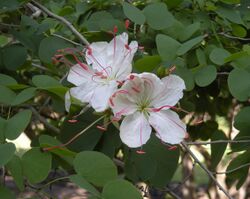Biology:Lysiphyllum
| Lysiphyllum | |
|---|---|

| |
| Lysiphyllum hookeri | |
| Scientific classification | |
| Kingdom: | Plantae |
| Clade: | Tracheophytes |
| Clade: | Angiosperms |
| Clade: | Eudicots |
| Clade: | Rosids |
| Order: | Fabales |
| Family: | Fabaceae |
| Subfamily: | Cercidoideae |
| Genus: | Lysiphyllum (Benth.) de Wit |
| Type species | |
| Lysiphyllum cunninghamii | |
| Species[1] | |
|
9; see text | |
Lysiphyllum[3][2] is a genus of flowering plants in the legume family, Fabaceae. It includes nine species of trees, semi-scandent shrubs, and lianas which range from India through Myanmar and Thailand to Peninsular Malaysia, Borneo, the Philippines, Java, the Lesser Sunda Islands, New Guinea, the Bismarck Archipelago, and Australia. Typical habitats include seasonally-dry tropical forest and woodland, vine thickets, Brigalow and Gidgee scrubland, floodplains, alluvial flats, tidal forest, mangroves, river and stream banks, and occasionally dunes and coral islets. They can grow on diverse soils including calcareous, granitic, and basaltic.[1]
The genus belongs to subfamily Cercidoideae[4] and tribe Bauhinieae.[5] It belongs to the subfamily Cercidoideae. It was formerly treated as part of the genus Bauhinia, but recent molecular phylogenetic analysis confirms that Lysiphyllum is a distinct genus from Bauhinia.[5] [6][7][8][9]
Species
Lysiphyllum comprises the following species:[1][10][11][12]
- Lysiphyllum binatum (Blanco) de Wit
- Lysiphyllum carronii (F. Muell.) Pedley—northern beantree, red bauhinia
- Lysiphyllum cunninghamii (Benth.) de Wit
- Lysiphyllum dewitii (K. Larsen & S. S. Larsen) Bandyop. & Ghoshal
- Lysiphyllum diphyllum (Buch.-Ham.) de Wit
- Lysiphyllum gilvum (Bailey) Pedley
- Lysiphyllum hookeri (F. Muell.) Pedley—white bauhinia, pegunny, mountain ebony, Queensland ebony, Hooker's bauhinia
- Lysiphyllum strychnifolium (W. G. Craib) A. Schmitz
- Lysiphyllum winitii (Craib) de Wit
References
- ↑ 1.0 1.1 1.2 [https://powo.science.kew.org/taxon/urn:lsid:ipni.org:names:22849-1 Lysiphyllum (Benth.) de Wit. Plants of the World Online. Retrieved 5 May 2023.
- ↑ 2.0 2.1 "Lysiphyllum | International Plant Names Index". https://www.ipni.org/n/102486-3.
- ↑ 3.0 3.1 , pp. 431, Wikidata Q94139373
- ↑ The Legume Phylogeny Working Group (LPWG). (2017). "A new subfamily classification of the Leguminosae based on a taxonomically comprehensive phylogeny". Taxon 66 (1): 44–77. doi:10.12705/661.3.
- ↑ 5.0 5.1 "The genus Bauhinia s.l. (Leguminosae): a phylogeny based on the plastid trnL–trnF region". Botany 87 (10): 947–960. 2009. doi:10.1139/B09-065.
- ↑ "Lysiphyllum" (Online, at kew.org). Legumes of the World. London, England: Royal Botanic Gardens, Kew. http://www.kew.org/science-research-data/lowo/TaxonomicView/SubFamily/Tribe/Genus/index.htm?kew_lowo_accepted_name_path=Lysiphyllum.
- ↑ "Phylogenetic Relationships in the Caesalpinioideae (Leguminosae) as Inferred from Chloroplast trnL Intron Sequences". Syst Bot 26 (3): 487–514. 2001. doi:10.1043/0363-6445-26.3.487. http://www.bioone.org/doi/full/10.1043/0363-6445-26.3.487.
- ↑ "Phylogenetic relationships in caesalpinioid legumes: a preliminary analysis based on morphological and molecular data". Advances in Legume Systematics, Part 10: Higher Level Systematics. Royal Botanic Gardens, Kew. 2003. pp. 37–62. ISBN 978-1-84246-054-2.
- ↑ "Phylogenetic patterns and diversification in the caesalpinioid legumes". Botany 86 (7): 697–718. 2008. doi:10.1139/b08-058.
- ↑ "ILDIS LegumeWeb entry for Lysiphyllum". Cardiff School of Computer Science & Informatics. http://www.ildis.org/LegumeWeb?version~10.01&genus~Lysiphyllum&species~.
- ↑ USDA; ARS. "GRIN species records of Lysiphyllum". National Germplasm Resources Laboratory, Beltsville, Maryland. http://www.ars-grin.gov/cgi-bin/npgs/html/splist.pl?15256.
- ↑ "Two new combinations in Lysiphyllum (Leguminosae-Caesalpinioideae)". Phytotaxa 178 (4): 298–300. 2014. doi:10.11646/phytotaxa.178.4.3. https://www.biotaxa.org/Phytotaxa/article/view/phytotaxa.178.4.3.
Wikidata ☰ Q3012200 entry
 |

